|
|
|
|
|
|
|
|
|
|
|
|
|
|
|
|
|
|
|
|
|
|
 |
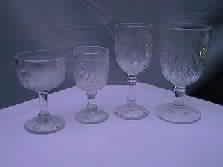 |
 |
 |
 |
|
|
|
 |
 |
 |
 |
 |
|
|
|
 |
 |
 |
| My Depression glass collection began by accident. A few weeks after we were married, my husband and I had friends over for dinner and I used a very delicate pitcher that we received as a wedding gift for the first (and last) time. It didn't survive the after dinner clean up. The next day, we went to a church flea market and I found an Iris & Herringbone pitcher and 6 tumblers that my husband bought for me to replace the previous evening's loss. They were my first pieces of depression glass. He paid $6 for the set. He thought he was getting off cheap right. Ten years and many thousands of dollars (and at least that many pieces of glass) later, I wonder if he regrets what he started. And so, I begin the A to Z patterns where I began. |
 |
|
|
 |
 |
 |
|
|
|
 |
 |
 |
| Iris & Herringbone was produced by the Jeannette Glass Company. It was |
| originally made in crystal from 1928 to 1932, though a few pieces were made |
| in pink and green during this period. Some crystal pieces were produced in |
| the 1940's, and specialized treatments such as satin finishes with hand |
| painted flowers or other applied colors probably date to this time. These |
| decorations are common on the fruit bowl, candlestick, nut bowl, 9 ½" and |
| 11 ½" ruffled bowls and the large serving plate. Red and gold decorated |
| sherbets are also found, which Gene Florence has dated to 1946 and |
| identified as "Corsage styled by Century". Jeannette seemed to be focusing |
| its 1940's production of Iris on giftware pieces rather than dinnerware |
| items. This may be the reason why dinner plates, luncheon plates, flat |
| tumblers and soup bowls are so hard to find. |
 |
|
 |
 |
 |
 |
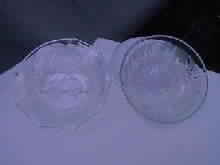 |
|
 |
 |
 |
 |
 |
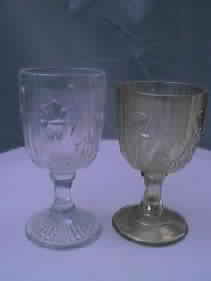 |
|
|
 |
 |
 |
 |
 |
 |
 |
 |
 |
 |
 |
|
|
|
 |
 |
 |
| There are a few pieces of Iris that can be a little confusing for new |
| collectors. Goblets come in two heights: 4 ½" and 5 ½". As you can see in the picture though, each height has two different size bowls. The 4 ½" size has a 3 oz wine and a 4 oz cocktail. The 5 ½" comes in a 4 oz wine and an 8 oz water goblet. Because of this, you need to know the height as well as the ounce measurement if you're buying sight unseen. Another confusing thing is that the footed tumbler comes in a 6 and 6 ½ inch size. That half inch isn't always easy to judge when you find one tumbler and have nothing |
| to compare it with. |
 |
|
 |
 |
 |
 |
 |
 |
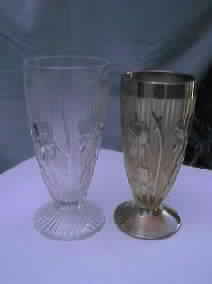 |
|
|
 |
 |
|
|
|
 |
 |
 |
| Ruffled bowls were made in 5 inch, 9 ½ inch and 11-½ inch size. The cereal bowl is also 5 inches in diameter, but the edge is straight. The difference in price between this ruffled bowl ($15.00) and the cereal bowl ($150.00) makes for a very costly mistake. The nut bowl and fruit bowls were made by |
| drilling a hole in the 11-½ inch ruffled bowl and adding a chrome base and centerpiece. Many of these are found with a satin finish. In the nut bowl, the center has holes for a nutcracker and picks, while the fruit bowl has 4 slits for fruit knives. The lampshade is also 11-½ inch, ruffled, and satinized, some having pink, blue or tan color sprayed on. The base of the |
| shade, however, has concentric rows that look like the Bubble pattern around the hole where the fixture would attach so that the bottom is not flat. If you put the lampshade on a table, it rocks. Don't let anyone sell you a fruit bowl without the chrome as a lampshade. |
 |
|
 |
 |
 |
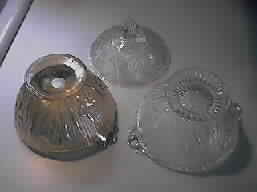 |
|
 |
 |
 |
 |
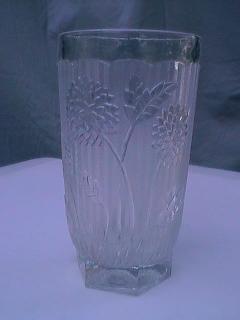 |
|
|
 |
 |
 |
 |
|
|
|
 |
 |
 |
| In the 1950's, Jeannette began making marigold, or iridescent, Iris & Herringbone. Although many pieces are the same shape as the original crystal, not all pieces were reissued, and some molds were reworked so that there are differences between the crystal and iridescent. The height of the 4 ½ inch wine goblet was changed to 4 inches by removing the half inch of clear glass from above the pattern. The candy jar bottom was made, but no lids were produced. The foot of these candy bottoms is plain while the original crystal jars have a rayed pattern on the foot. This is very important to remember because in the late 1960's through the '70's, candy bottoms were made in crystal with color flashed on them and sold to florists. When the color peels off, you're left with a crystal candy bottom that could be mistaken for the older style. Vases were also made during the 1970's in milk glass with red, pink, green, and blue sprayed on. Don't confuse these with the original issue pink and green vases. The old pink and green is transparent and only the vase, sugar, creamer and 9 ½" ruffled |
| bowl have been found in these two colors. |
| I'm not going to list all the pieces that were made in the Iris & |
| Herringbone pattern as you can find them in any depression glass |
| encyclopedia. What I will do is share with you a few things I've learned |
| in13 years of collecting. First, Iris is common in my area (Long Island, |
| N.Y.) but this is not true in other areas of the country. When I brought |
| home my pitcher and glasses, my Dad pulled out the same set that he had purchased in Woolworth's for my Grandma when he was a little boy. Woolworth's may have heavily marketed it and, as Woolworth's stores were everywhere in and around New York City until this year, this may have something to do with its availability. Second, even with its availability, some pieces just aren't turning up. I have yet to find luncheon plates, flat tumblers, demitasse saucers, and beaded edge bowls in crystal as I scour the local markets. Lastly, just because a piece is supposed to be common, doesn't mean you'll be able to find it. I hunted for two years to replace an iridescent set of candlesticks. In that time, I found and bought 13 dinner plates at reasonable prices. Of course, everyone knows that you never find what you're looking for when you need it most. |
| In closing, I'd like to share with you something interesting that turned up 8 years ago. The tumbler pictured here is a pattern is called |
| Herringbone & Mums and the only reference I have been able to find to this piece is in Bill Edwards' Standard Encyclopedia of Carnival Glass. He says, "Made by Jeannette Glass in the late 1920's, this rare depression era tumbler is a close relative to the Iris & Herringbone pattern made by the same company." Gene Florence confirmed the name for me, but thought it was produced in the 1950's. Edwards pictures it in marigold; my tumbler is crystal. Perhaps it was originally made in the 1920's and reissued in the 1950's along with the iridescent Iris. And so far, no one has been able to tell me if any other pieces were produced in this pattern. If anyone can help, please do! If I get enough information, you know what next month's column will be about. |
| Thanks for stopping by! |
|
| Bibliography |
| Edwards, Bill. Standard Encyclopedia of Carnival Glass, 4th Edition. |
| Paducah, KY: Collector Books, 1994. |
|
| Florence, Gene. Collector's Encyclopedia of Depression Glass, 13th Edition.Paducah, KY: Collector Books, 1998 |
|
| All photographs from the author's personal collection. |
 |
|
|
 |
 |
 |
 |
 |
 |
 |
|
|





